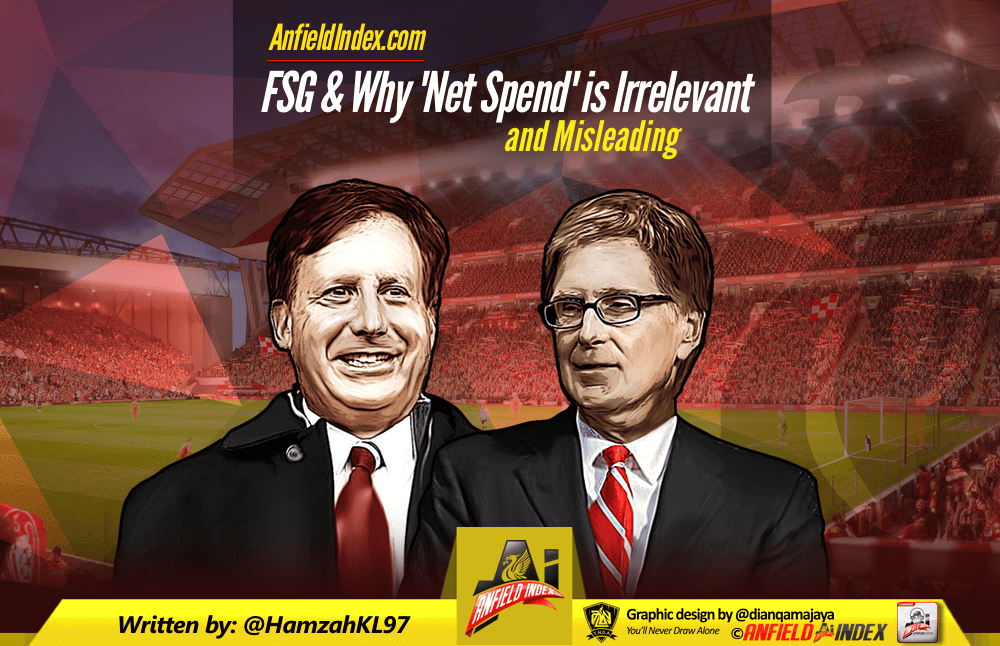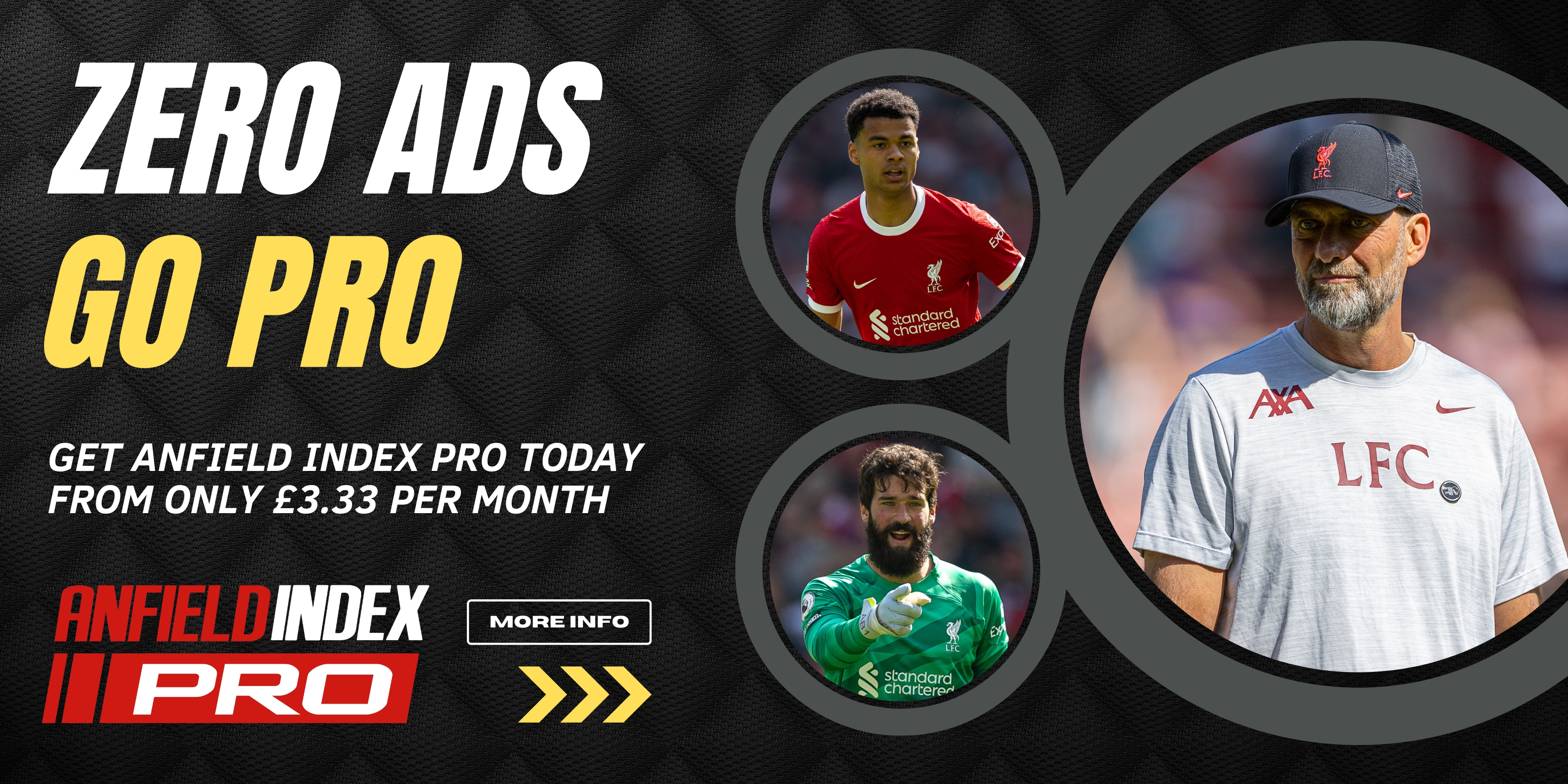Today, I read a popular article on the Echo website titled ‘FSG – how much have Liverpool’s owners really invested in players?’.
It’s undeniably an interesting read, but one that is misleading – though I do not hold the writer culpable for this. The very nature of the premise ‘how much have Liverpool’s owners really invested in players’ is unfortunately caught up with a great deal of misinformation that stems from the transfer orientated reporting of club business.
The result of this is that the football discourse is almost exclusively limited to results and transfers. Pick up any newspaper – bar the Financial Times (whose sports coverage is enlightening) – or go to any online mainstream sports outlet and you’ll likely find the vast majority of articles only cover transfers, transfer gossip, match build-up and match reports.
Ownership of a football club extends well beyond this though: there is far more than just transfers that contribute to a club’s business. Take revenue for instance:
‘Finances and financial strength in the football world mean more than ever before, but despite the support of John Henry, personally valued at 2.5 billion USD, Liverpool FC lags behind its English rivals, as the fifth richest club in the league, according to Deloitte.
Manchester United sit at the top of the Deloitte Money League with total revenues of 515.3m GBP: 20pc (£102.8m) derived from matchday revenue, of which broadcasting rights make up 27pc (£140.4m), and 53pc of that total (£272.1m) comes from commercial sources.
Fifth in the world, but second in the Premier League is Manchester City, with a 2016 revenue of 392.6m GBP. A mere 13pc comes from matchdays (£52.5m), 41pc from broadcasting rights (£161.4m), but a huge 46pc is sourced from commercial deals (£178.7m).
Sitting 7th in the world and third in the PL is Arsenal. The total revenues amount to 350.4m GBP: matchday accounts for 29pc of the total (£99.9m), broadcasting 41pc (£143.6m), and commercial 30pc (£106.9m).
Just behind Arsenal are Chelsea, 8th in the world. Total revenues stand at 334.6m GBP, with matchdays contributing 21pc (£69.7m), broadcasting 43pc (£142.9m) and commercial 36pc (£122m).
Liverpool in comparison are only one spot behind Chelsea, at ninth globally. Total revenues only amount to 302m GBP, 19pc of which is from matchdays (£56.8m), 42pc from broadcasting (£125.7m) and 39pc from commercial deals (£119.5m)
Liverpool’s matchday revenues outstrip Manchester City’s, but are below all other competitors, stressing the need to expand Anfield. Liverpool struggled in terms of broadcasting rights, but these figures were calculated following Liverpool’s first season under Klopp, and broadcasting revenues are expected to be lower considering Liverpool were not in the Champions League. In terms of commercial deals, Liverpool are in a stronger position than both Arsenal and Chelsea, but when it comes to overall revenues we must account for the historical context.
In 2012, Manchester United’s revenues stood at €396m, now they stand at €689m: a percentage increase of 73.9pc. Likewise Manchester City’s revenue growth from €286m in 2012 to €525m in 2016 is a phenomenal increase of 83.6pc. Arsenal’s growth from €290m to €469m amounts to a 61.7pc rise. Whilst Chelsea’s €323m to €447m is the smallest of any of the Deloitte Top 10 English teams, at 38.4pc.
Comparatively, Liverpool’s €233m in 2012 to €404m in 2016 was an increase of 73.4pc, beaten only by the two Manchester clubs, both of whom have financial and structural resources far greater than those of Liverpool FC.
In this sense, FSG can only be applauded for their efforts – achieving a percentage growth in revenues over four years comparable to both Manchester City and United, and better than that of Arsenal and Chelsea, not only illustrating how far Liverpool were behind its competitors, but also how far it has come.’
*Figures sourced from: https://www2.deloitte.com/uk/en/pages/sports-business-group/articles/deloitte-football-money-league.html
(Excerpt from my article, The Seven Year Itch | FSG – A Review, June 2017)
Below, are the ‘net spend’ figures that are garnering sizeable attention:
Man City: £718.05m
Man United: £540.05m
Chelsea: £351.8m
Arsenal: £179.8m
Liverpool: £164m
Spurs: -£20.5m
Considering this data collection started in 2010, it’s hardly surprising to see where Liverpool is. Once on the verge of bankruptcy, and then struggling domestically, and appearing infrequently in Europe – you would expect Liverpool’s expenditure to reflect its position as a club, and the propensity and ability of it to ‘spend big’. Manchester City, for instance, has undergone an immense programme of redevelopment, in which the club grew artificially (rather than through organic investment and natural growth), from a mid-table team to a title challenger, then to a potential Champions League contender. Chelsea and Manchester United, contrariwise, have expenditure that reflects that of teams that are winning titles, and thus have the ability to spend at such a rate. Although, United were able to call upon their vast resources to fund a regeneration programme of sorts after the Moyes premiership. But this does not even begin to scratch the surface of reflecting ‘investment’.
If you want to understand why Liverpool’s transfer expenditure has been the way it is, we need to understand what contributes to it in the first place, and it’s plainly obvious that a club cannot spend money it does not have, nor cannot borrow – as a loan is dependent upon some sort of security or guarantee, and if a club has revenues that show it cannot afford a loan, then no financier will lend the club money, let alone to spend on transfers.
Hence, for Liverpool to compete with its rivals on the field, in terms of players and squads, it would have to increase its revenues first for a few reasons: one being so that the club meets FFP regulations, another being to satisfice Liverpool’s board members and shareholders – who are beholden to business objectives – and the third being so that the club can keep pace with its rivals in terms of transfer and wage fees.
Contrary to popular opinion, transfer budgets are not just sums of money set aside each year, in cash, sealed in a vault beneath the Anfield pitch. Like any other type of spending, it’s costed and structured, which is why clubs ‘prepare’ bids, rather than simply throwing cash at one another.
If you would really like to comprehend how much Liverpool’s owners have ‘invested’ in players, you would have to account for the new training ground, wages, bonuses, perks and so on. Limiting ‘investment’ to mere net spend is simply ridiculous, and there is no scope to a net spend analysis, relative to an evaluation on an ownership’s success.
To evaluate investment though, we would have to return to revenues and revenue growth. The three tweets below illustrate Liverpool’s commercial and overall revenue growth (please note Liverpool’s line is yellow in the first tweet, and green in the second).
#MUFC commercial revenue up 3% (£7m) from £268m to £276m, due to full year contribution from Adidas deal & growth in Megastore sales. pic.twitter.com/uXUehG7ePx
— Swiss Ramble (@SwissRamble) September 28, 2017
Over last 5 years revenue growth at #THFC much lower than top 5 clubs, so gap has grown wider (7/19) pic.twitter.com/ZGdrszOL37
— Swiss Ramble (@SwissRamble) April 6, 2017
#MUFC commercial income of £268m significantly higher than other English clubs (10/19) pic.twitter.com/Xe82gEmpvg
— Swiss Ramble (@SwissRamble) April 6, 2017
Liverpool’s revenue growth has actually been surprisingly strong, considering Liverpool’s on-field record since 2011, managing to close the gap on both Chelsea and Arsenal. However, you’ll likely not hear much about that because a sensationalist story on how Liverpool have a £200m ‘transfer kitty’ is far likelier to gain attention, and interest the readership. Which is why the focus of the popular article currently doing the rounds is solely ‘net spend’.
Yet, even here when it comes to analysing the success of an ownership, there’s still far more than just net transfer expenditure and revenue growth to look at though. And even when we do look at them, we must understand how both may be skewed or present a story that is not representative of the reality. Take transfer spending, for instance, which reached dizzying heights only a mere few months ago, when PSG signed Neymar for c.€200m.
c.€200m is a great deal more than the £80m that Real Madrid paid for Cristiano Ronaldo, yet would you call Real Madrid’s owners poor for having a lower net spend than PSG? Of course not, because there’s no context to the figures, with Ronaldo’s fee agreed in 2009, in a market we could likely characterise as inflated, but not to the degree of today’s market – in which Barcelona was willing to pay over a tenth of Liverpool FC’s value for Philippe Coutinho.
What else then can we use as a barometer for ‘investment’ by the ownership?
‘Investing’ in wages
If we cast our minds back to 2010 when FSG (then NESV) purchased Liverpool, Liverpool’s finances were in near tatters. At the same point, Manchester City’s ascent to footballing superpower was underway, as they finished third, equal on points with Chelsea. At that point, Manchester City tore apart the conventional rule book – especially with regard to wages:
Impact of #MCFC group restructure on wage bill evident since 2013 (15/19) pic.twitter.com/0PPc2E3i1R
— Swiss Ramble (@SwissRamble) April 6, 2017
Highest wage growth over last 5 years at #LFC and #MUFC both with £79m (16/19) pic.twitter.com/RKmpVwIfUC
— Swiss Ramble (@SwissRamble) April 6, 2017
In response to that, Liverpool made a concerted effort to close the wage deficit between them and their competitors, through increased revenues. We saw a large number of deals being struck early on in FSG’s ownership, with Garuda Indonesia, Dunkin’ Donuts, Hugo Boss, Warrior and then New Balance all springing to mind. Since 2015, the rate of commercial growth has slowed, but that’s the nature of contractual sponsorships – so whilst Manchester United were able to strike a world record Adidas kit deal, not long ago, Liverpool will have to wait until their current contract with New Balance is up for renewal before negotiating a new kit package.
Now though, Liverpool have probably got their wage structure wrong, with an expenditure that does not quite equal the value of the squad – due to early deals made, in an attempt to compensate for Liverpool’s lack of competitiveness. But this was the case with Manchester City too, who spent extremely high in terms of wages in order to break into the top four through recruiting players, only to replace and improve upon those players over time, with a more meaningful and sensible structure laid for the long-term.
For instance, whilst Joe Cole was on in excess of £100,000 p/w, now both Salah and Mané are reportedly on £90,000 p/w – clear evidence of a restructuring towards a more sustainable, and rewarding (for players) model.
Why the ‘net spend’ numbers don’t add up (proverbially)
When we take the summer transfer window of 2014, which saw the sale of Luis Suarez to Barcelona, Liverpool’s transfer expenditure was undeniably high, with c.£129m spent on new players. In terms of net spend, it was still high – with c.£44.34 million – largely offset by the sale of Suarez. Yet here, with a high net spend, this was a poor window with Can, Lambert, Lallana, Markovic, Lovren, Origi and Balotelli all brought in, none of whom hit the ground at the pace expected. Liverpool subsequently dropped out of the Champions League group stages and languished in sixth place come the final game of the season.
Put simply, net spend means nothing without context. Yet when we do add context, it’s still not a clear indicator of anything. For instance, Liverpool has spent similar fees on Sadio Mané, Mohamed Salah and Andy Carroll. Yet in January 2011, £35m GBP held a great deal more weight than it did in the summer of 2016, when Liverpool signed Mané. Transfers, transfer expenditure and quality against transfer expenditure is not uniform though. For instance, whilst Liverpool’s net expenditure in January 2011 – relative to the market in 2011 – may have been high (£20.8m) the quality received for that expenditure was, in certain instances, over or underinflated.
Suarez for instance, at c.£24m was a bargain, whilst Carroll at c.£35m (c.£2.5m more than what Manchester City would spend on Agüero a few months later) throws everything out of proportion. And here, with this can we finally come to create criteria to make sense of transfer fees.
Transfer fees should be judged on an individual basis. After all, it’s a transaction that is (usually) exclusively between two parties, and dependant on a number of factors. For instance, there’s the remaining length of a contract: e.g. Coutinho signed a new (release-clause free) contract in January 2017, hence Barcelona could not tempt Liverpool with their offers, whilst if Juventus made an offer for Emre Can during the summer 2017 window, for lets say, £20m, Liverpool would have been far likelier to accept it – considering Juventus are free to make an attempt to sign him to a pre-contract in January of 2018. Then there’s the willingness of a player to move, or unwillingness of a club to sell: Naby Keïta’s transfer to Liverpool is a fantastic instance we can use to explain this too. Leipzig were unwilling to sell, despite Liverpool offering a greater sum for an immediate transfer than one a year later – because of his release clause. Yet because the club was adamant Keïta would not be leaving in 2017, Liverpool managed to secure a remarkable deal, which actually worked out cheaper. Despite this, the club is somehow being arraigned for striking such a deal, because ‘net spend’ is lower because of it.
Another example we can take is Mario Götze, who, in this case, was sold for c.£31.5m to Bayern Munich, in 2013 – at that point a German record fee. Here though we can see inflation is not uniform – so while c.£31.5m was the German record in 2013, Chelsea had already smashed that with the purchase of Torres back in January 2011. The very same player was sold back to Dortmund for a lesser fee – his price had actually fallen, in a market in which prices, generally, are perceived to be rising.
Once we realise inflation is not uniform, the whole idea of net expenditure as a category by which to judge ownerships falls apart. The transfer of Paul Pogba is another good example: Paul Pogba cost Manchester United c.£89m alone, without accounting for his wages – reportedly around the £300,000 p/w mark. Meanwhile, Kante signed for closer to £32m. Does this mean Manchester United had the better transfer window, and their owners are better? Of course not. A transfer window’s success should be judged on the quality, quantity and suitability of players brought in, and their value for money, whilst an ownership can only be judged through a synoptic-style approach – analysing actions, mistakes, corrections, old habits or evolution.
Here’s another example of how net spend does not even begin to tell the full story:
Largest profits from player sales #CFC £49m & #LFC £42m (3/19) pic.twitter.com/PoUjqFo54W
— Swiss Ramble (@SwissRamble) April 6, 2017
Largest profits before tax from #MUFC £49m, #THFC £38m & #MCFC £20m. Highest losses #AVFC £81m & #CFC £71m (2/19) pic.twitter.com/577VwAU0fn
— Swiss Ramble (@SwissRamble) April 6, 2017
In 2015/16, Liverpool made £42m ‘profit’ on player sales, the second most in the league, yet, at the same time, posted an official £20m loss. Indeed, there are greater running costs to club outside of transfer fees – there’s the obvious cost of wages, bonuses, taxes, dividends but also the cost of interest too – which we should not forget, considering the club still holds a sizeable debt and was on the brink of bankruptcy less than a decade ago. It’s irrational and absurd to expect the club to be spending at an unsustainable rate, just because its vastly wealthier rivals are.
Indeed, for all the talk of ‘net spend’, Liverpool managed to finish above both Arsenal and Manchester United in 2016/17, and spent considerable money on the new Main Stand. ‘Net spend’ does not necessarily correlate with success, and people would do well to remember that.
And for those asking, only Man Utd and Chelsea had a higher total wage bill than #lfc in the 2015-16 financial year.
— David Phillips (@lovefutebol) October 10, 2017
So FSG are "investing" (a term I don't particularly like applying here) more in wages than H&G did, whilst "investing" in Anfield & Kirkby.
— David Phillips (@lovefutebol) October 10, 2017
Not my position, but am curious as to response had LFC sold Coutinho, then spent c.£50m on Anfield Road expansion/£60m+ on new player(s).
— David Phillips (@lovefutebol) October 10, 2017
And in case you think there might have been "better" owners out there than FSG at the time? https://t.co/oyhN8dHclp
— David Phillips (@lovefutebol) October 10, 2017
In sum, ‘net spend’ is a non-issue. It’s an oversimplification of a fairly complex issue. Net transfer expenditure only reflects upon a fraction of real investment and it’s remarkable that it gains so much attention, and the calculation is in relation to an arbitrary ‘transfer kitty’ upon which we have no genuine details or understanding of. Anyone can do some simple maths, comparing spend to sales in a given period of time, but there is so much more to understand when it comes to ‘investing’ in a football club, and I would urge anyone that wishes to discuss the ownership, its success, or at least Liverpool’s success in the transfer window with respect to that.
Allow me a small digression to end: ‘net spend’ is simply a number. Imagine I ended this piece with the number ‘54.71’. You would have no idea what the number means, the value of it, and which scale to judge it by. The very same is true of net spend!
Next time you hear someone mention net spend, ask them if they really know what it means.















Oh I see.So that is how the FSG apologists see our world beating performances!
Apologist c##t.. FSGOUT
Too many people love FSG and not Liverpool Football Club which I don’t understand why 7 years of failure. I don’t want another 7 years of FSG
We were in trouble… but how long can FSG be excused for saving us? Net spend is the best barometer as it demonstrates how much squad investment is happening. And ours is well behind the other key rivals for trophies. FSG have done what they can and it hasnt brought any success for 7 years. Its time their poor tenure came to an end and we get owners who care. How come none of the 150m tv money has been re-invested in the squad – only a £40m? FSG out
John our highest net spend under FSG’s stewardship got us Balotelli, Markovic & Lambert. What’s your point?
fsgout ….signing young inexperienced players that might hold a resale value is not structure set up for success …structure set up for failure so fsg can spend as little as possible…shit policies that don’t work…..not looking a for a sugar daddy just want football minded people on board that dont look to be top of the profit table..instead of buying 6 inexperienced players buy 2 world class players(be clever so u dont have to keep spending on crap players wasting the clubs money not fsg’s money remember that) and stop the bullshit and making excuses for a bullshit structure that fails the fans every season…..
We sold Suarez and replaced with 3 average players, because they wouldn’t cough up the market rate on – world class star. World class players are not attracted by their moneyball approach… they wanna win stuff which doesn’t happen when ur constantly cashing in on ur best players. We need owners who are gonna spend and reinvest to build a squad. FSG are not those owners. Thanks, but they’ve had enough time to build. It’s their company and they’re running it to make cash but not take it forward. New owners please. FSG out